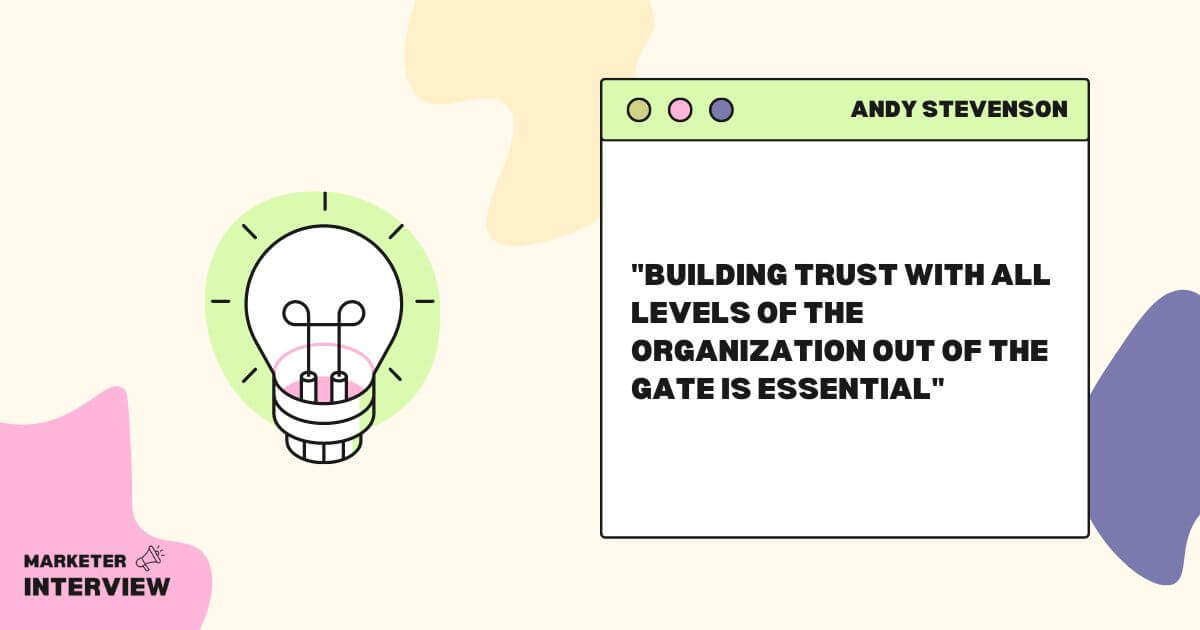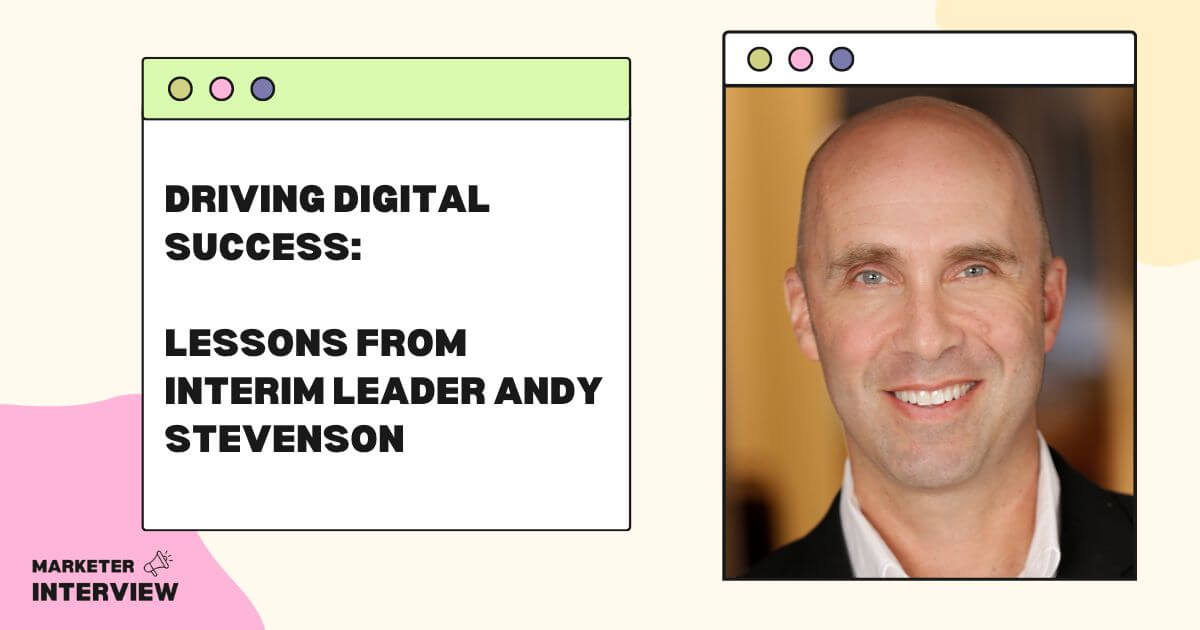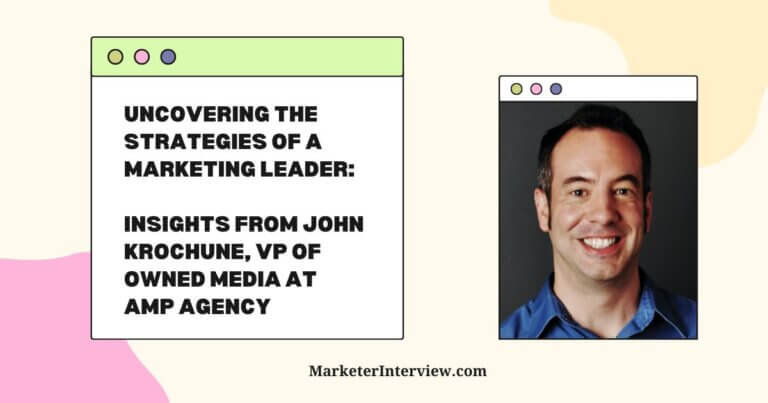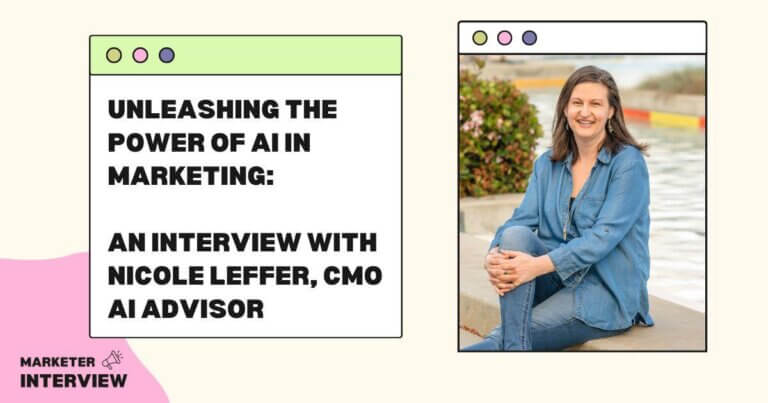Driving Digital Success: Lessons from Interim Leader Andy Stevenson
Welcome to Marketer Interview, where we engage in insightful conversations with remarkable marketers shaping the digital landscape.
Today, we are honored to speak with Andy Stevenson, an industry veteran and a proven leader in digital marketing and eCommerce.
With an impressive track record of driving record revenues and providing interim leadership to a diverse range of companies, including big names like Dell, Williams Sonoma, and Bass Pro Shops, Andy’s expertise is second to none.
Join us as we explore his invaluable insights and lessons from a career over two decades.
Contents
- 1 Andy, you’ve had a remarkable journey in the marketing world. Could you share with us how you first got involved in this dynamic field and what drove you to pursue a digital leadership and eCommerce career?
- 2 As an interim leader, you’ve worked with startups and established companies. How do you adapt your strategies and leadership style to suit the unique challenges each organization faces?
- 3 Omnichannel and multichannel strategies are essential for modern businesses. Can you tell us some of the most effective strategies you’ve implemented to create seamless customer experiences across different channels?
- 4 Digital marketing encompasses various elements like SEM, SEO, affiliates, and advertising. How do you prioritize and integrate these components to create a cohesive and successful marketing campaign?
- 5 Website and mobile design play a crucial role in engaging customers. What principles do you follow to ensure your design and re-platforming efforts align with the brand’s identity and drive conversions?
- 6 Organizational optimization and development are essential to sustainable growth. How do you identify areas of improvement within a company’s structure and foster a culture of continuous growth and innovation?
- 7 Merchandising and analytics are essential for understanding customer behavior and preferences. How do you leverage data-driven insights to enhance merchandising strategies and boost sales performance?
- 8 Email, social media, and content development are powerful tools for engaging audiences. What strategies do you employ to create compelling content that resonates with your target customers and drives meaningful interactions?
- 9 Vendor discovery, selection, and negotiations are critical for successful partnerships. When choosing vendors, what criteria do you consider, and how do you ensure mutually beneficial collaborations?
- 10 With your extensive experience in international business management and expansion, what advice do you have for companies looking to enter new global markets and overcome international challenges?
- 11 What do you like best about being an interim resource?
I got hooked in the ’90s when I witnessed my wife locate a cancer specialist for her sister and get her admitted to Sloan Kettering from across the country.
Later, when I was in business school, I looked into applications of this new thing called the Internet and how it could transform how companies sell their products and communicate with customers. I took this passion first to one of the early interactive agencies, then to Dell, where we grew our online sales from $100M to more than $2B in three years.
Things have changed significantly since then, but it’s always about finding new ways to deliver a great customer experience.
As an interim leader, you’ve worked with startups and established companies. How do you adapt your strategies and leadership style to suit the unique challenges each organization faces?
Whether I work with a new company or a large enterprise, it always starts with the same question: Is there a clear and well-understood brand vision? Can the right people, processes, and tools help them deliver on that vision? All too often, the answer is “No.”
When I’m working with smaller companies, it’s often about taking their foundational idea or product and operationalizing it. It’ll help build a roadmap, introduce agency partners, find new employees and resources, and introduce best practices in each digital discipline.
With medium-sized or large companies, it’s more about prioritization. They’ve hired talented, ambitious individuals who’ve generated many good ideas. And yet the broader company org structure and decision-making interfere with getting actual business-driving initiatives done.
In this scenario, my contribution is more about role clarification, improving processes, and setting priorities aligning with the company’s vision and goals. It seems simple, but the teams are tied in so many knots and pulled in so many directions that they settle for crossing items off the list rather than keeping an eye on true growth drivers.
Omnichannel and multichannel strategies are essential for modern businesses. Can you tell us some of the most effective strategies you’ve implemented to create seamless customer experiences across different channels?
There are foundational aspects, including striving for a 360-degree customer view through data and enabling an omnichannel experience through capabilities such as “Buy Online, Pickup in Store.”
Where breakthroughs happen is when a company tunes into its customers. That certainly includes research; however, as Steve Jobs said: “Our job is to figure out what they’re going to want before they do.” Understanding customer journeys, desires, and intent that’s what I mean by tuning in. How do we help prospects and customers identify their core needs? Research and understand their options.
I like to piece together data and qualitative insights (including reading reviews and conducting in-home observations) to understand consumers’ needs and then build hypotheses on best delivering on those needs.
Simultaneously, it’s extremely helpful to communicate within a company to ensure everyone is aligned with what we’re trying to deliver in a broader sense and then explore how each function can contribute to bringing the experience to life.
Digital marketing encompasses various elements like SEM, SEO, affiliates, and advertising. How do you prioritize and integrate these components to create a cohesive and successful marketing campaign?
For me, it begins with mapping a company’s current channel and program participation against the customer lifecycle (Awareness, consideration, engagement, etc.) and assessing gaps, strengths, and weaknesses. Is the company attracting ample site visitors but not converting them? Is it converting customers, but they’re not coming back? These are all indicators of where to focus.
It then comes down to good planning and good creativity. What are the key messages and language that should be present in search engine marketing? How can they be creatively and compellingly brought to life via social channels and the website?
Like many marketers, I like to use a view of the marketing funnel to evaluate the relative weighting of each channel. If a new company is selling a product requiring substantial education, adequate attention must be paid to the top of the funnel. The emphasis shifts toward lower funnel activities if it’s a well-recognized company with a robust and differentiated product. Regardless, there needs to be a blend of activities to fill the funnel and draw shoppers toward a purchase.
Finally, a cross-channel content calendar, complemented by creative briefs (or at least a few bullets describing the campaign goals, key messages, offers, and channel participation), must be developed and used to help ensure the customer experience is consistent and compelling.

Website and mobile design play a crucial role in engaging customers. What principles do you follow to ensure your design and re-platforming efforts align with the brand’s identity and drive conversions?
The site and mobile redesigns and relaunches are a big lever to pull–and one I’ve often reached for. But the question that companies often fail to ask is, “Why are we redesigning the site?” When that’s not answered, disappointment follows, as the website might look more pleasing but doesn’t improve the customer experience.
I like to begin any related project by answering the above question. At the core of this is identifying the essential “tasks” visitors want to complete and how effectively they can complete them.
Sometimes, the focus is researching options, learning about the brand, and then heading to a retail location. Other times, it’s getting product support. Understanding customer segments and priorities goes a long way toward designing the ideal experience.
Of course, working with design resources that take a customer-centric perspective and focus on navigation, flows, and information before launching into designs is essential.
Organizational optimization and development are essential to sustainable growth. How do you identify areas of improvement within a company’s structure and foster a culture of continuous growth and innovation?
It goes back to two areas: Vision and the customer lifecycle. But I’m getting ahead of myself.
Building trust with all levels of the organization out of the gate is essential. If they know you’re there first and foremost to help them, as individuals, meaningfully contribute to the company’s success and that I can offer relevant experience and insights, it’s easier to learn what is and isn’t working. That is, transparency is everything.
Back to the vision. Does everyone know what the company’s working toward? And do individuals see how their efforts contribute? If not, then it’s critical to nail down the vision.
As for the customer lifecycle, just as it’s a framework for evaluating marketing gaps, strengths, and weaknesses, it’s also one for evaluating the organization. Do key stages of the lifecycle have champions? There should be a strong leader who excels at raising awareness and attracting visitors, another who profoundly understands the product or service, one who’s great at delivering a great shopping experience, and one who knows how to build a community and bring customers back. Often, these elements are shared across multiple leaders and team members, but when they’re ignored, the visitor suffers.

Merchandising and analytics are essential for understanding customer behavior and preferences. How do you leverage data-driven insights to enhance merchandising strategies and boost sales performance?
I use a combination of dashboards and ad-hoc analysis to give a sense of the big picture, including trends, blips, and outliers. The data needs to be sliced in multiple ways: channel performance, product category performance, site behavior, and all of the relevant KPIs for each.
I then look at categories and products that attract visits but aren’t converting, or vice versa. That’s when the ad hoc analysis comes in. What’s different about these under or over-performing categories/products? Are we attracting the wrong audience? Are product benefits unclear? Is pricing a factor? Understanding what’s driving performance shifts is crucial, not overreacting to them.
Of course, testing is a critical element, whether split testing emails, trying alternative copies, or observing sessions and heatmaps.
It’s pretty simple: Offer value and take the perspective of the reader/visitor.
People engage when there’s value in engaging, whether learning something new, getting current on trends, sharing their experiences, or saving more. I don’t make every piece of content about driving the sale but rather about engaging the audience. That means planning topics, researching, and offering lively and personal creativity.
Vendor discovery, selection, and negotiations are critical for successful partnerships. When choosing vendors, what criteria do you consider, and how do you ensure mutually beneficial collaborations?
It begins with understanding the core business need and the landscape of possible providers. Among them, which is the right size for my company or client?
It’s no help to be a small fish in a big pond or to overbuy. Nor is underspending and being hamstrung by the lack of functionality. I’ll often start with the vendors I’ve worked with and supplement that list with Gartner data, if available, and/or sources like G2 to ensure I’m not missing good candidates.
I then schedule conversations with the top 3-5 vendors. These are extremely telling. Do they come out of the blocks selling me, or do they listen to the business needs and tailor their information accordingly? Do they speak as a partner or as someone with all the answers?
As for the negotiations, I look for the ability to scale pricing according to the company’s size and the flexibility to adjust or cancel the contract if the fit is not good or the company’s fortunes change.
With your extensive experience in international business management and expansion, what advice do you have for companies looking to enter new global markets and overcome international challenges?
I picture a surfer repeatedly swimming against waves, trying to break through to smooth waters. That is, patience, understanding, and time are all critical.
Companies often fail to understand foreign markets’ unique attributes, from the basics, such as rules, taxes, and regulations, to consumer preferences and behavior.
Engage experts who have unfolded an international presence to understand what logical expansion sequencing looks like. Engage others who know the nuances of each market.
Finally, ensure management and the organization understand this is like surfing. They’ll be learning and falling, but eventually, that primo wave is out there.
What do you like best about being an interim resource?
Driving business results, while critical, isn’t the most important. It’s about leaving the business in a better place and positioned for sustainable growth.
A vision (and goals) universally understood and embraced. Empowered and engaged employees. An experience that customers value and share.






